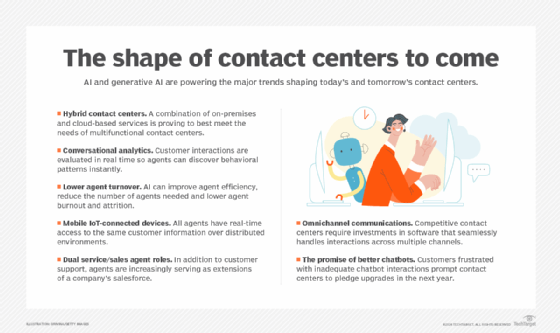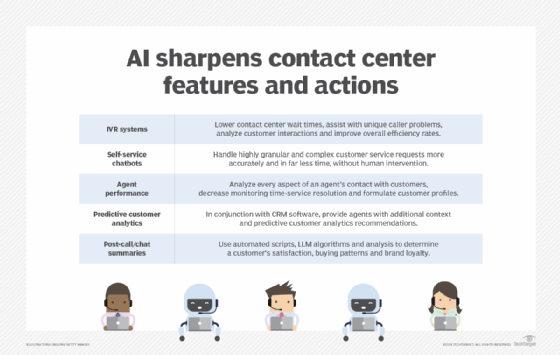7 contact center trends for 2024 and beyond
As contact centers trend toward becoming viable profit centers, AI's influence is at the core of conversational analytics, omnichannel communications and a mobile-first strategy.
Businesses chasing the elusive goal of turning contact centers into profit centers have renewed hope with the arrival of artificial intelligence.
AI holds the promise of eliminating many barriers that have prevented contact centers from turning a profit. Among the challenges confronting businesses are more efficiently integrating AI with existing technology resources, increasing the productivity of contact center agents while lowering IT costs, reducing high agent turnover rates in on-premises locations, providing better omnichannel customer support and easing the process of establishing a hybrid operation that enables agents in remote locations to be closer to customers.
Businesses, however, shouldn't view AI as a panacea to cure all their ills. They need to thoroughly research what it takes to implement a full-blown AI strategy in their contact centers.
"We recognize that AI is a powerful capability, but it needs to be harnessed and [contact centers] shouldn't develop their overall strategy around it," said Brad Cleveland, senior advisor and co-founder of contact center management consultancy ICMI. "For instance, there is much hype around AI reducing workloads, but we haven't seen that materialize yet. We encourage users to be clear-eyed about what their workloads will look like in the coming months and not paint themselves into a corner with their budgets by assuming AI will displace everything."
AI is the most significant contact center trend in 2024 and should remain so well into the future. But its importance could prove even greater as a change agent triggering a number of other technology trends that in turn will serve to revamp the way contact centers conduct business.
1. Hybrid contact centers here to stay
Despite growing interest among many on-premises contact centers to expand their operations by adopting contact center as a service, most platform vendors are finding it difficult to become exclusive as-a-service providers. In fact, many businesses are discovering that a combination of on premises and as a service is producing more than satisfactory results. The ability to support multiple channels, including email, phone, websites and live chat used in concert with a customer experience management platform -- a practice known as unified CXM -- enables companies to combine customer interactions and insights on a single platform.
"The hybrid approach is going to continue," Cleveland reasoned. "It's going to be hard to completely let go of on-premises agents. They are still very necessary. I'm very optimistic about AI being a game changer but don't expect it to displace physical contact centers next week. That's not happening."

2. Conversational analytics in real time
Identified by some analysts as critical to the future of contact centers, conversational analytics extracts data from text and voice conversations between customers and human agents or chatbots. Customer interactions are evaluated in real time so agents can discover behavioral patterns instantly. Agents acquire a more in-depth understanding of each customer through past data and journey insights.
"Conversational analytics will be something customers can benefit from," Cleveland said. "But [contact centers] must scrub existing data to make sure the data is accurate and up to date. Otherwise, agents could be handing out bad information."
3. Fewer agents and lower agent turnover due to AI
A survey of contact center professionals conducted by market researcher and advisory firm Metrigy discovered that 28% of agents quit their jobs in 2023 largely due to burnout -- the highest percentage recorded in the survey's history. In conversations with contact center managers over the past couple of years, Metrigy president and principal analyst Irwin Lazar said the biggest high-level trend has been to improve agent efficiency. But managers said their agents were feeling frustrated because they couldn't get the information customers needed, resulting in poor customer service.
"An increasing number of companies are not implementing AI for AI's sake," Lazar reported. "They are mainly using AI to reduce the number of agents they need and make the current agents more productive. We found that companies investing in AI to support agent interactions had 89% fewer agents and so had fewer layoffs and, generally, they got better analytics out of their contact centers."
AI-based software, Lazar added, also reduced "after call" work in which agents must trace back after a call to capture their notes and sort out what action items they need to pursue. Agent after call work dropped by 35%, potentially enabling agents to handle more calls effectively.

4. Renewed focus on mobile IoT-connected devices
Contact centers are now focusing on mobile-first capabilities that could transform business processes and improve agent productivity, particularly among remote agents. Some 10 billion devices are actively in play and connected to IoT with expectations of 25.4 billion units by 2030, presenting enormous opportunities for contact centers. A mobile-first strategy provides agents access to customer data from a central repository using any device from any location. This approach helps IoT make any agent the "right agent" for a customer to contact because all parties have access to the same information.
"We have seen increasing interest among contact centers for using IoT devices especially for supporting use cases in manufacturing, retail and health care," Lazar explained. "Agents can have real-time access to help with telemedicine scenarios where they can read data from a diabetes sensor on their arm up to cases involving technical support questions among health-related companies."
Contact centers are thinking more seriously about IoT-based strategies especially for applications involving security, app development and general connectivity needs, according to Jack Gold, president and principal analyst at consultancy J. Gold Associates. But contact centers, he added, will have to do a better job managing what could be hundreds of remote devices and knowing what data each device is touching.
"People have little or no knowledge of IoT and other connected devices and the data they're sending and receiving over the network," Gold said. "This is where distributed contact center agent support comes in and lends a hand with all that. It would be nice to have hold of data in the on-premises facility telling you when you need to update or replace remote devices."
5. Dual roles for distributed contact center agents
Contact centers have had distributed agents for some time, but most recently organizations are placing more strategic importance on them as communication technologies improve. Remote agents located geographically closer to customers can make face-to-face meetings more productive, especially in solving technology problems. These agents also are increasingly serving as extensions of a company's salesforce, which is seen as another way to help contact centers become profit centers.
"Contact centers are not serving as support centers anymore, but they're beginning to serve as point-of-sale centers," Gold said. "Once they've addressed customers' technical support questions, they can try to upsell them on other products and services. AI can provide agents with data on customers such as their likes and dislikes to see if they are good candidates for more than just support."
But not everyone sees this as a viable way to bring in added revenues. "Many remote people in contact centers have a number of responsibilities, including help desk functions," said Frank Dzubeck, president of Communications Network Architects. "So, after an agent spends time solving a technical problem, they are going to launch into a sales pitch? Well, an agent customarily is not looking for that, in fact they could get a little pissed off about that."

6. Seamless omnichannel communications
Many contact centers are exploring the possibilities of implementing true omnichannel in their operation, but few have implemented a fully working system -- and for good reason. Omnichannel requires a lot of work. Call centers looking to graduate to a true cloud-based contact center must put in place the necessary software that can seamlessly handle interactions with customers across multiple channels.
Those channels could include phone, email, texts and a variety of social media platforms. Customers typically use multiple channels over the course of one transaction and demand that the experience look and feel the same. Therefore, contact centers must have an automatic call distributor that intelligently routes contacts from multiple channels. They'll also need a workforce management system that can accurately predict volume levels for different channels as well as agent-facing tools that provide agents with the necessary customer data and conversation history.
"Many contact centers have a full-time channel in place, but not so many have an omnichannel in place and working right now," Cleveland acknowledged. "It's important for users who can't get the information they need and be able to seamlessly move among multiple channels like websites or a mobile app in real time. I see omnichannel as the next necessary trend in AI."
7. Significantly improved chatbots … maybe
Chatbots and other automated systems that handle customer questions during initial contact with the company have received mixed reviews from customers who say too often the options offered for solving their specific problem aren't adequate. Contact centers pledge to upgrade chatbots over the next year, but progress has been slow.
"Some users I talk to find chatbots infuriating and will hang up on a call when they sense their questions can't be answered," Gold noted. "Vendors are working to cure this problem, and the overwhelming trend to do so over the next year is with the integration of AI. There are a lot of things available to address this problem, but not a lot of contact centers are very far along in adopting them." Still, chatbots and automated customer service are expected to be among the more significant advances that will define the future of contact centers.
Robotic process automation figures to play a significant role automating repetitive and manual tasks in contact centers, greatly reducing the time agents spend handling such responsibilities. RPA, for example, could allow agents to access customer profiles along with the details of previous engagements with the contact center so they can more quickly present callers with solutions to their individual problems. RPA can also play a role in data validation as chatbots begin to cross-reference information from multiple systems and databases to ensure accuracy.
Ed Scannell is a freelance writer based in Needham, Mass. He writes about a broad range of technologies and issues facing corporate IT professionals. He can be reached at [email protected].







